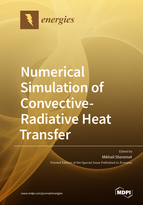Numerical Simulation of Convective-Radiative Heat Transfer
A special issue of Energies (ISSN 1996-1073). This special issue belongs to the section "J: Thermal Management".
Deadline for manuscript submissions: closed (25 May 2020) | Viewed by 38949
Special Issue Editor
Interests: heat and mass transfer; natural convection; porous media; phase change materials; computational fluid dynamics; heat transfer enhancement
Special Issues, Collections and Topics in MDPI journals
Special Issue Information
Dear colleagues,
Heat transfer is the main transport process for various engineering and natural systems. At the same time, the development of modern engineering apparatus and natural bio- and geo-systems is related to a deep understanding of the processes that have progressed in these systems. Convective and radiative heat transfer mechanisms are the dominant modes in the considered systems. Therefore, an in-depth study of these regimes is very important and useful for both the growth of industry and the preservation of natural resources. There are three main methods for an investigation of the considered heat transfer mechanisms. They are theoretical methods, experimental methods, and computational approaches. Theoretical methods are related, generally, to an analytical description of thermal processes using the laws of conservation of mass, momentum, angular momentum, and energy, while experimental analysis deals with an investigation of heat transfer processes using experimental techniques and measurements. The development of computer engineering allows one to use the plentiful opportunities of numerical simulation to obtain a description and an understanding of heat transfer processes. Such an approach includes the advantages of theoretical methods in which analysis can be performed in a wide range of all governing parameters and the advantages of experimental methods where the deep investigation is possible. Therefore, numerical simulation of convective and radiative heat transfer is a very useful and important topic for different fields of industry and various natural systems.
The present Special Issue will focus on the simulation of convective and radiative heat transfer in engineering systems and natural bio- and geo-systems. It is a very good opportunity to combine original manuscripts on the considered topic to present useful guidelines for future research.
Prof. Dr. Mikhail Sheremet
Guest Editor
Manuscript Submission Information
Manuscripts should be submitted online at www.mdpi.com by registering and logging in to this website. Once you are registered, click here to go to the submission form. Manuscripts can be submitted until the deadline. All submissions that pass pre-check are peer-reviewed. Accepted papers will be published continuously in the journal (as soon as accepted) and will be listed together on the special issue website. Research articles, review articles as well as short communications are invited. For planned papers, a title and short abstract (about 100 words) can be sent to the Editorial Office for announcement on this website.
Submitted manuscripts should not have been published previously, nor be under consideration for publication elsewhere (except conference proceedings papers). All manuscripts are thoroughly refereed through a single-blind peer-review process. A guide for authors and other relevant information for submission of manuscripts is available on the Instructions for Authors page. Energies is an international peer-reviewed open access semimonthly journal published by MDPI.
Please visit the Instructions for Authors page before submitting a manuscript. The Article Processing Charge (APC) for publication in this open access journal is 2600 CHF (Swiss Francs). Submitted papers should be well formatted and use good English. Authors may use MDPI's English editing service prior to publication or during author revisions.
Keywords
- convective heat and mass transfer
- radiative heat transfer
- turbulent transport
- phase change materials
- porous media
- nanofluids
- electronics cooling
- heat exchangers
- solar collectors
- thermal power plants
- bio- and geo-systems






